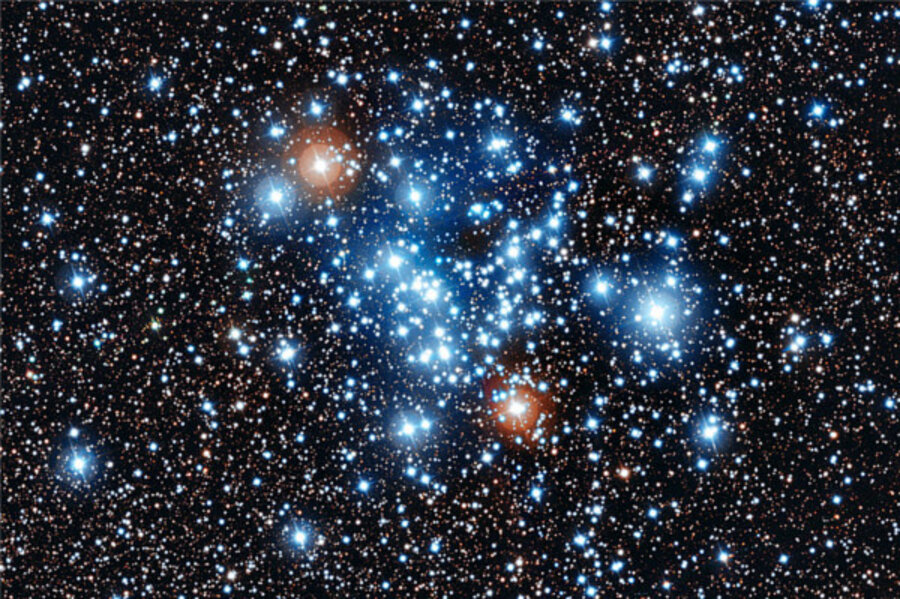Little Green Men? New type of star breaks all the pulsar rules
Loading...
Isaac Asimov reportedly said, "The most exciting phrase to hear in science, the one that heralds new discoveries, is not "Eureka!" but "Hmm. That's funny..."
Recently, a group of Swiss astronomers found something very funny indeed: slowly pulsating stars. Pulsating stars, a type of variable stars, typically pulse quickly – from a few times per hour to over a thousand times per second. But these newly discovered stars are brightening only once every two to 20 hours.
“The very existence of this new class of variable stars is a challenge to astrophysicists,” says Sophie Saesen, a member of the research team, in a press release.
Not only are these stars incredibly slow, but their pulse is weak: they're only getting only 0.1 percent brighter with each pulse. Spotting such a tiny variation, with such a remarkably slow period, took astronomers years.
“We have reached this level of sensitivity thanks to the high quality of the observations, combined with a very careful analysis of the data,” says Nami Mowlavi, leader of the research team, “but also because we have carried out an extensive observation programme that lasted for seven years."
The telescope they used, a Swiss 1.2-metre Euler telescope at the European Southern Observatory's La Silla Observatory in Chile, is too small for most astronomy, which turned out to be a blessing, says Dr. Mowlave, who is based at the Geneva Observatory. "It probably wouldn’t have been possible to get so much observing time on a bigger telescope.”
For seven years, the research team observed more than 3,000 young stars in the star cluster NGC 3766 for a few weeks each year. They found variable stars – 163 of them – including 36 that seem to break all the rules of pulsars. In fact, they held off on labeling the stars "pulsars," choosing the less controversial label of "periodic variable stars," though they said that they expect the scientific community to confirm that they are, in fact, pulsars.
So what's a pulsar, anyway?
Pulsars, stars whose brightness appears to "pulse" at regular intervals, were first identified in 1967. Almost fifty years later, astronomers still haven't figured out exactly why they pulse, but most agree on this much:
Pulsars are born in supernovae. When a massive star explodes, its core is compressed into a neutron star: a star with no protons or electrons, just an unbelievably dense lump of neutrons, about 10 trillion times denser than lead, spinning incredibly quickly.
Think about a figure skater with her arms outstretched. When she pulls them in, she spins faster and faster, not because she's adding effort, but because the original energy of her spin is now being applied over a smaller radius. Now imagine that she started as a spinning star – a star many times larger than our own sun – and then shrunk down to a rock a few miles across. Now that's a fast spin.
As the neutron star whips around, its energy generates a beam of light (or X-rays, or gamma rays, or radio waves), shining out along its magnetic axis – which may not be the same as its rotational axis. The gap between the magnetic and rotational axes allows the beam to be visible once every rotation. That's the pulse that gives pulsars their name.
Eventually, the star slows down, and it no longer produces a beam of radiation. Astronomers call this the "death line." Neutron stars cross the "death line" between 10 and 100 million years after their supernova. That time limit on pulsars is one reason astronomers look for pulsars in groups of young stars, like NGC 3766, which is about 20 million years old.
Astronomers have found pulsars that spin every few milliseconds, while the slowest-known X-ray pulsars spin only once or twice an hour.
If these newly discovered variable stars are confirmed as pulsars, despite spinning only once every 2 to 20 hours, then they're long past the "death line" – which means that the whole theory of how pulsars are formed might need to be revised.
Little Green Men
The first pulsar ever found was spotted by a young graduate student, Jocelyn Bell, who saw it tick-tick-ticking like a metronome every 1.33 seconds. Unable to imagine what could have caused such a regular signal, Bell and her advisor began to wonder if intelligent aliens were flashing a signal at Earth. They began to describe the unknown source of the pulses as LGM-1, for Little Green Men.
As she described it later,
"We did not really believe that we had picked up signals from another civilization, but obviously the idea had crossed our minds and we had no proof that it was an entirely natural radio emission. It is an interesting problem – if one thinks one may have detected life elsewhere in the universe how does one announce the results responsibly? Who does one tell first?"
Fortunately, before they made the big announcement that they had proof of alien intelligence, Bell found another pulsar in another part of the sky – and then two more. Even the most eager alien hunter would have found it unlikely that four different groups of aliens were all flashing signals at the same speed.
In 1974, Bell's advisor, Antony Hewish, was awarded the Nobel Prize for Physics for the discovery of pulsars, making him the first astronomer to win the prize. Bell did not share in the prize.
In 1993, another Nobel Prize was awarded for research on variable stars, this time to the team that discovered eclipsing binaries – and used them to confirm Albert Einstein's theory of general relativity.








